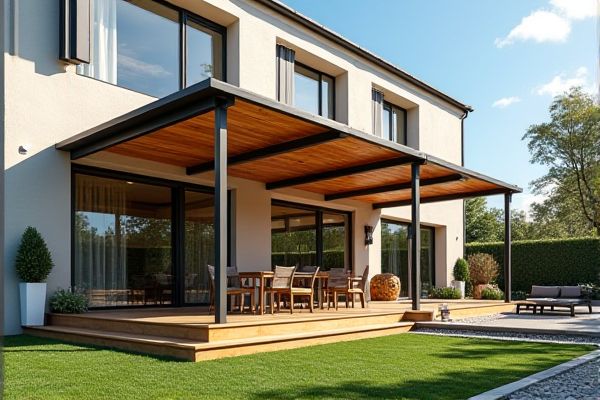
A retractable awning offers flexible shade and sun protection with easy operation, perfect for adjusting coverage based on weather conditions, while a pergola cover provides a fixed structure that combines aesthetic appeal with partial shading and support for climbing plants. Discover which option best suits Your outdoor space needs by exploring the detailed comparison in the rest of this article.
Table of Comparison
| Feature | Retractable Awning | Pergola Cover |
|---|---|---|
| Design | Flexible, extendable fabric canopy | Fixed or adjustable slatted roof |
| Installation | Wall-mounted, easy to retract | Permanent structure, ground or wall mounted |
| Sun Protection | Full shade when extended | Partial to full shade depending on cover type |
| Weather Resistance | Retracts during strong wind or rain | Offers better stability in bad weather |
| Cost | Generally more affordable | Higher initial investment |
| Maintenance | Requires regular cleaning and fabric care | Minimal, depends on materials used |
| Durability | Moderate, fabric may wear over time | High, sturdy construction materials |
| Customization | Wide range of fabric colors and patterns | Customizable structure and roofing options |
Overview: Retractable Awning vs Pergola Cover
Retractable awnings offer flexible shading solutions with adjustable fabric panels that extend or retract using manual or motorized controls, ideal for customizable sun protection on decks or patios. Pergola covers typically consist of fixed or adjustable slatted roofs made from wood, metal, or fabric designed to provide structured shade and aesthetic appeal while allowing airflow and some light penetration. Your choice depends on whether you prioritize versatility and space-saving features with a retractable awning or durable, architectural enhancement with a pergola cover.
Design and Aesthetic Differences
Retractable awnings offer a sleek, modern design with flexible fabric options that seamlessly blend into your home's exterior, allowing you to adjust coverage based on sunlight and weather. Pergola covers, often constructed from wood, aluminum, or vinyl, provide a more permanent, architectural structure that enhances outdoor aesthetics with customizable slats or solid panels. Your choice depends on whether you prefer the minimalist, space-saving look of a retractable awning or the classic, sturdy charm of a pergola cover.
Installation Process and Requirements
Retractable awnings typically require a sturdy mounting surface such as a wall or roof, with installation involving brackets, arms, and fabric that can be extended or retracted manually or motorized for convenience. Pergola covers often necessitate building a supportive frame made of wood, metal, or vinyl, requiring more extensive labor and possibly professional assistance due to the need for structural stability. Your choice depends on available space, installation complexity, and whether you prefer a fixed or flexible shade solution.
Durability and Weather Protection
Retractable awnings typically feature durable, weather-resistant fabrics such as acrylic or vinyl coated polyester, providing effective protection against sun, light rain, and UV rays while allowing for easy retraction during severe weather. Pergola covers, often made from wood, aluminum, or polycarbonate panels, offer sturdy structural durability and superior protection against heavier rain and wind but lack the flexibility of retractable systems. Choosing between the two depends on the desired balance between permanent weather shielding and adjustable coverage for varying conditions.
Cost Comparison and Value
Retractable awnings typically cost between $500 and $3,000, offering affordable flexibility for shading patios, while pergola covers range from $2,000 to $7,000 due to their permanent structure and materials like wood or aluminum. Retractable awnings provide excellent value for homeowners seeking adjustable sun protection and quick installation at a lower price point. Pergola covers add long-term home value with enhanced outdoor living space and durability, making them a cost-effective investment despite the higher initial expense.
Maintenance and Longevity
Retractable awnings typically require less maintenance due to their fabric design and ability to be retracted during harsh weather, extending their lifespan. Pergola covers, often made from wood or metal, demand regular upkeep such as sealing, painting, or rust prevention to ensure longevity. Investing in high-quality materials for both options can significantly enhance durability and reduce long-term maintenance efforts.
Customization and Flexibility
Retractable awnings offer superior customization and flexibility with adjustable angles and extension lengths, allowing you to control sunlight and shade precisely throughout the day. Pergola covers provide a more permanent structure, often customizable with materials like fabric or slats but lack the quick adaptability of retractable designs. Choosing between the two depends on your preference for dynamic shade control versus a fixed, decorative outdoor feature.
Shade and Sunlight Control
Retractable awnings offer precise shade and sunlight control with adjustable fabric that you can extend or retract based on your needs, providing flexibility during varying weather conditions. Pergola covers, often made from slats or fabric panels, allow partial sunlight to filter through, creating a more natural and airy shade environment. Choosing between these options depends on whether you prioritize customizable sun protection or a more open, decorative outdoor space for your comfort.
Energy Efficiency and Comfort
Retractable awnings provide superior energy efficiency by blocking direct sunlight and reducing indoor heat gain, which lowers cooling costs during hot months. Pergola covers offer enhanced comfort through their structural design, allowing partial shade and airflow while supporting climbing plants for natural cooling effects. Both options improve outdoor living comfort, but retractable awnings deliver more precise control over shading and temperature regulation.
Best Use Cases for Each Option
Retractable awnings are ideal for homeowners seeking flexible shade solutions that can be easily extended or retracted based on sunlight or weather conditions, perfect for patios, decks, and outdoor dining areas. Pergola covers suit outdoor spaces where structural aesthetics and partial shade are desired, providing support for climbing plants and creating a semi-permanent shelter ideal for gardens and backyard lounges. Both options enhance outdoor living but differ in adaptability and design, making retractable awnings better for dynamic coverage and pergola covers optimal for decorative, fixed protection.
 homyna.com
homyna.com